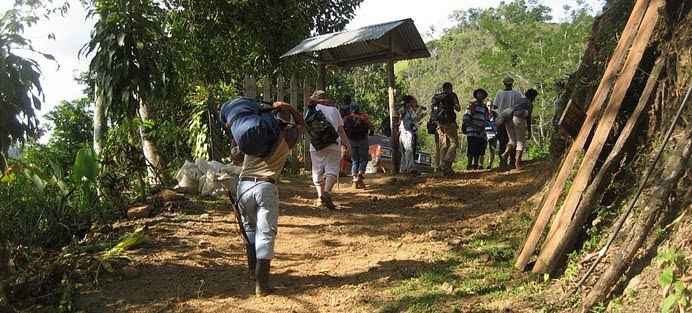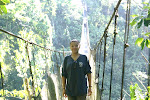Friday, February 5, 2010
Volcanoes in Costa Rica and Pittsburgh?
LaShai, 16
Friday, we learned a lot about Costa Rican geology and how it differs from where we live here in Pittsburgh. For starters, Pittsburgh doesn’t have any volcanoes. Costa Rica on the other hand has more than 5 volcanoes on its isthmus. All the volcanoes in Costa Rica are stratovolcanoes. This means that they have explosive eruptions. When volcanoes have explosive eruptions, they have sticky lava, and eruptions aren’t as frequent.
Because of these types of eruptions, it affects the society a lot. There were several instances to where people, mostly farmers, had to move away because the ash that was coming from the volcanoes wasn’t very healthy. It also ruined the crops they had planted. This is a problem because if the farmers don’t have anything to grow or sell, they won’t make a profit. Also people won’t get the food they need.
Friday, we learned a lot about Costa Rican geology and how it differs from where we live here in Pittsburgh. For starters, Pittsburgh doesn’t have any volcanoes. Costa Rica on the other hand has more than 5 volcanoes on its isthmus. All the volcanoes in Costa Rica are stratovolcanoes. This means that they have explosive eruptions. When volcanoes have explosive eruptions, they have sticky lava, and eruptions aren’t as frequent.
Because of these types of eruptions, it affects the society a lot. There were several instances to where people, mostly farmers, had to move away because the ash that was coming from the volcanoes wasn’t very healthy. It also ruined the crops they had planted. This is a problem because if the farmers don’t have anything to grow or sell, they won’t make a profit. Also people won’t get the food they need.
Who are the Ticos?

Alyssa, 17
Costa Ricans, also known as ticos, come from a variety of different origins, but share the same traditions and values in their country. These origins include the Spanish, Europeans (mainly German and Swiss), African slaves, and the Natives. Out of the 3.96 million people living in Costa Rica, only 40,000, or 1% are indigenous natives of Costa Rica. This is partially because many of the native Costa Ricans died of sickness when the Spanish colonists came to Costa Rica. Ticos live very peaceful lives, and are considered to be some of the happiest people on Earth. In 1949, after the civil war, Costa Rica created a constitution, in which the army has been abolished ever since. Ticos are proud of their neutrality. In addition, the constitution allowed Africans to be granted citizenship and women were allowed to vote.
Tico society is far from urban, and Costa Rica has the highest rural population density in Latin America. The only true city located in Costa Rica is San Jose, the capital. Rural ticos live a simple life, spending time tending to animals and crops, or as cowboys in Guanacastae. The three most popular crops grown in Costa Rica exported to other countries are bananas, coffee, and sugar. Also, the vast majority of ticos retain ties to the land, including those who live in the city. Homes often have a small garden if they are not located in the rural parts of the country. Costa Rica’s geography includes volcanoes, rainforests, oceans, and beaches. Costa Rica is also considered an isthmus because it is connected to land on the top and bottom, but is otherwise surrounded by water. To the west, the country is surrounded by the Pacific Ocean, and on the east, the Caribbean Sea. I look forward to being able to see the country of Costa Rica as well as the ticos culture and traditions.
Geology of Costa Rica and how it differs from Pittsburgh

Nathan, 17
During the past two days in class we have been studying the geology of Costa Rica comparing it to Pittsburgh’s. What I gathered from these activities were the different kinds of volcanoes, the types of eruptions, the hazards, and the advantages. There are three types of volcanoes in the world. These are shield, cinder cone, and composite. Shield volcanoes are volcanoes that are made of basaltic lava and that are really flat. Cinder cone volcanoes are made of pyroclastic rock, and these are volcanoes that look like pointy mountains. The last type of volcano is composite volcanoes. These volcanoes are made up of different layer of pyroclastic, and lava flows. Costa Rica is mainly full of composite type volcanoes. These volcanoes mainly have eruptions that are explosive and spew out gases. The hazards of volcanoes in the short run are that the gases are deadly, and lava flows are very dangerous. The advantages of volcanoes are that the heat produced by the lava can be stored and use to produce electricity. Another advantage that volcanoes give is that the ash is very useful for growing coffee beans, and bananas because the soil becomes so rich. The biggest reason to why there are so many volcanoes in Costa Rica and not in Pittsburgh is the tectonic processes of the Earth, and where the plates are located. Costa Rica is on the edge of a convergent boundary which means that the two plates run into each other and form mountains/volcanoes. Pittsburgh on the other hand is nowhere near the edge of a plate boundary which means there are no formations of volcanoes. During the assignments in class we used Google Earth to help us learn about tectonic plates and the volcanoes of Costa Rica. We had to find out where the closest tectonic plate boundary was from Pittsburgh. The closest one to the east is 2,209.41 miles. The closest one to the west is California. Other things we looked at using Google Earth was who close the nearest volcano was to San Jose. The closest volcano is Barva which is 13.29 miles away from the city. Then we had to find out where the closest plate boundary was to Costa Rica. The closest boundary is 90.45 miles off the western coast of Costa Rica. Another interesting fact that I found out was that a lot of the volcanoes in Costa Rica are very active.
All information came from information we learned in class, Google Earth, and the National Geographic Costa Rica Book.
Subscribe to:
Comments (Atom)









